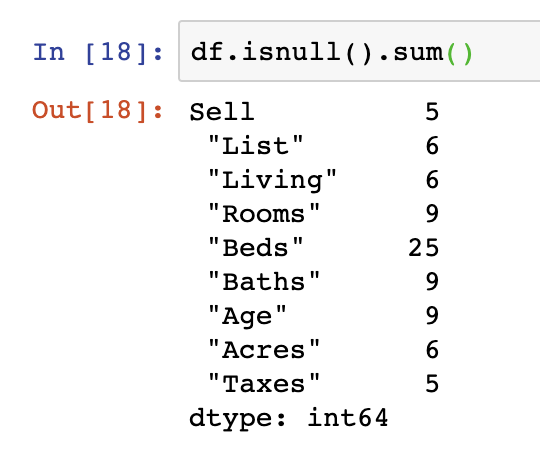To summarize, you've learned how to get column names from the pandas dataframe in different scenarios. The keys of the dictionary are the DataFrame's column labels, and the dictionary values are the data values in the corresponding DataFrame columns. The values can be contained in a tuple, list, one-dimensional NumPy array, Pandas Series object, or one of several other data types. You can also provide a single value that will be copied along the entire column. Use DataFrame.isnull().Values.any() method to check if there are any missing data in pandas DataFrame, missing data is represented as NaN or None values in DataFrame. When your data contains NaN or None, using this method returns the boolean value True otherwise returns False.
After identifying the columns with NaN, sometimes you may want to replace NaN with zero value or replace NaN with a blank or empty string. As you can see, .dtypes returns a Series object with the column names as labels and the corresponding data types as values. Therefore we can use the pandas.isnull() method to remove the NaN and 'nan' value from the list or an array in Python.
In this tutorial, you'll learn the different methods available to get column names from the pandas dataframe. In most cases, you'll use the DataFrame constructor and provide the data, labels, and other information. You can pass the data as a two-dimensional list, tuple, or NumPy array. You can also pass it as a dictionary or Pandas Series instance, or as one of several other data types not covered in this tutorial.
Now suppose we do not know the type of the list or if the list contains the data of various data types. You can do this by using the select_dtypes() method available in the dataframe. It'll return a subset of dataframe columns based on the dataframe types. Then you can use the columns property on the subset to get the column names.
DataFrame.isnull().sum() – returns a total count of missing values for each column and datatype. That's why this blog is particular for the cell value focus. We have seen pandas and numpy, both methods to check missing values. We focus on the concept only to show simple tutorials and not use any iteration loop. All the above methods which we discussed are fast in execution even if you want to check the whole dataframe.
The most important and only mandatory parameter of .astype() is dtype. If you pass a dictionary, then the keys are the column names and the values are your desired corresponding data types. This value is passed to the list() method to get the column names as list. In the sample dataframe, only the Unit_Price column is a float column.
You can extract rows/columns containing missing values from pandas.DataFrame by using the isnull() or isna() method that checks if an element is a missing value. Also, you have learned how to get the count of NaN values using DataFrame.isnull().sum().sum() method. By using isnull().values.any() method you can check if a pandas DataFrame contains NaN/None values in any cell (all rows & columns ). This method returns True if it finds NaN/None on any cell of a DataFrame, returns False when not found. In this article, I will explain how to check if any value is NaN in a pandas DataFrame. One way to filter by rows in Pandas is to use boolean expression.
We first create a boolean variable by taking the column of interest and checking if its value equals to the specific value that we want to select/keep. For example, let us filter the dataframe or subset the dataframe based on year's value 2002. We covered a lot of ground in Part 1 of our pandas tutorial. We went from the basics of pandas DataFrames to indexing and computations.
If you're still not confident with Pandas, you might want to check out the Dataquest pandas Course. In this tutorial, we'll dive into one of the most powerful aspects of pandas — its grouping and aggregation functionality. With this functionality, it's dead simple to compute group summary statistics, discover patterns, and slice up your data in various ways. Since Thanksgiving was just last week, we'll use a dataset on what Americans typically eat for Thanksgiving dinner as we explore the pandas library. It contains 1058 online survey responses collected by FiveThirtyEight.
This dataset will allow us to discover regional and income-based patterns in what Americans eat for Thanksgiving dinner. As we explore the data and try to find patterns, we'll be heavily using the grouping and aggregation functionality of pandas. In this section, you'll learn how to get a list from dataframe column headers based on the data type of the column. In this section, you'll learn how to list column names and types of each column of the dataframe.
Now let's take an example and solve this problem by iterating the column names. To do this task first we have created a DataFrame object 'df' in which we have assigned a specific column name 'Numbers'. Once you will print 'df' then the output will show the 'Numbers' value index of a DataFrame.
Use the dropna() method to extract rows/columns where all elements are non-missing values, i.e., remove rows/columns containing missing values. Here we see that the first value for our time series was given a randomly selected NaN value . This value, along with identical NaN entries, will represent the missing data we'll be using Pandas to replace.
If you wish to save such data for convenience the DataFrame.to_csv() method is recommended. Pandas is a highly utilized data science library for the Python programming language. Pandas dataframes are great for analyzing and manipulating data. In this tutorial, we will look at how to get the max value in one or more columns of a pandas dataframe with the help of some examples. Let's identify all locations in the survey data that have null data values. The isnull method will compare each cell with a null value.
If an element has a null value, it will be assigned a value of True in the output object. And we get a dataframe with number of missing values for each column. As you can see, the data types for the columns age and py-score in the DataFrame df are both int64, which represents 64-bit (or 8-byte) integers.
However, df_ also offers a smaller, 32-bit (4-byte) integer data type called int32. If a NaN value occurs in an array or a list, it can create problems and errors in the calculations. We will also look into ways to remove the string values nan from the list in this tutorial. We can remove the NaN or 'nan' values from the list, by using the following methods. You can get column names as list by using the .columns.values property of the dataframe and converting it to a list using the tolist() method as shown below.
There are a handful of other methods available for the DataFrame.isnull() method that are described in the official Pandas documentation. For more information on the values().any() method see the official NumPy documentation for the np.array object. Now that we know our data contains missing values we can formulate an approach to begin replacing the data as we best see fit. Manytimes we create a DataFrame from an exsisting dataset and it might contain some missing values in any column or row. A Column must specify the properties of a column in a dataframe object.
It can be optionally verified for its data type,null values or duplicate values. The column can be coerced into the specified type, and therequired parameter allows control over whether or not the column is allowed to be missing. When you have a bigger dataframe, we can quickly make a bar plot using Pandas' plot.bar function to get the sense of missing values. We use dot operator to chain the results of isna().sum() to reset_index() to name the result column and use plot.bar to make a quick bar plot.
We can use Pandas' sum() function to get the counts of missing values per each column in the dataframe. In this post we will see how can we get the counts of missing values in each column of a Pandas dataframe. Dealing with missing values is one of the common tasks in doing data analysis with real data. A quick understanding on the number of missing values will help in deciding the next step of the analysis. Pandas usually represents missing data with NaN values.
In Python, you can get NaN with float('nan'), math.nan, or numpy.nan. Starting with Pandas 1.0, newer types like BooleanDtype, Int8Dtype, Int16Dtype, Int32Dtype, and Int64Dtype use pandas.NA as a missing value. You can use it to get entire rows or columns, or their parts. You can use it to get entire rows or columns, as well as their parts. In this table, the first row contains the column labels (name, city, age, and py-score).
You can use the below code snippet to get column names from pandas dataframe. To use as an example, remove rows and columns where all values are missing values. The concept is the same when extracting columns with missing values in a specific row. Use loc[] to select by name , and iloc[] to select by position.
If you want to extract rows with missing values in a specific column, use the result of isnull() for that column. Write a Pandas program to find integer index of rows with missing data in a given dataframe. In the above example, we checked the NaN value using the isnull method of the dataframe. This method belongs to the numpy and not the dataframe. The below program is for that which checks only for the particular cell.
The main documentation of the pandas is saying null values are missing values. We can denote the missing or null values as NaN in the pandas as most developers do. The NaN and None keywords are both used by developers to show the missing values in the dataframe. The best thing in the pandas is that it treats both NaN and None similarly.
To check the missing value of a cell, pandas.notnull will return False in both cases of NaN and None if the cell has NaN or None. One area that needs to be discussed is that there are multiple ways to call an aggregation function. As shown above, you may pass a list of functions to apply to one or more columns of data.
One of the most basic analysis functions is grouping and aggregating data. In some cases, this level of analysis may be sufficient to answer business questions. In other instances, this activity might be the first step in a more complex data science analysis.
In pandas, the groupbyfunction can be combined with one or more aggregation functions to quickly and easily summarize data. This concept is deceptively simple and most new pandas users will understand this concept. However, they might be surprised at how useful complex aggregation functions can be for supporting sophisticated analysis. Here, created a subset dataframe with the columns we wanted and then applied the max() function. We can pass a list of column names too, as an index to select columns in that order. We will use Palmer Penguins data to count the missing values in each column.
The latest version of Seaborn has Palmer penguins data set and we will use that. Missing data is very common in data science and machine learning. Pandas has very powerful features for working with missing data.
In fact, its documentation has an entire section dedicated to working with missing data. In addition to extracting a particular item, you can apply other sequence operations, including iterating through the labels of rows or columns. However, this is rarely necessary since Pandas offers other ways to iterate over DataFrames, which you'll see in a later section. Now, let's suppose that the number list is converted to string type, and we want to check if it contains any NaN values. After converting into the string type, the NaN value becomes a string equal to 'nan' and can be easily detected and remove by comparing it with 'nan'.
This tutorial will look into various methods to find and remove the NaN values from the list in Python. The NaN value in programming means Not a Number, which means the variable's value is not a number. Sorted() function sorts the list of values passed to it. So when you pass the dataframe to it, it'll sort the column headers in an alphabetical way and return it as list.
In this section, you'll learn how to get column names with duplicate values. This can be useful when you want to identify the columns which have duplicates. You can get the column names as an array by using the .columns.values property of the dataframe.
To get the combined total count of NaN values, use isnull().sum().sum() on DataFrame. The below example returns the total count of NaN values from all columns. Sometimes rather than dropping NA values, you'd rather replace them with a valid value. This value might be a single number like zero, or it might be some sort of imputation or interpolation from the good values.

























No comments:
Post a Comment
Note: Only a member of this blog may post a comment.